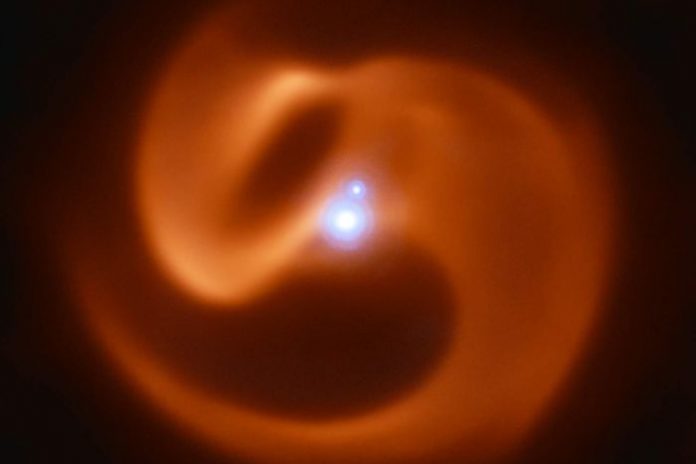Eight thousand light-years away in a constellation called Norma, a spectacular spiral of gas and dust is churning around a doomed star system like we’ve never seen before.
Writing in the journal Nature Astronomy, its discoverers claim the stars at the centre of the turmoil are primed to produce the most extreme explosion known to astronomy: a gamma ray burst.
“This is the first time we’ve seen all of the ingredients to make one of those particular events, all wrapped up in one place,” said study co-author Peter Tuthill of the University of Sydney.
He and his colleagues dubbed the swirling formation Apep, in honour of the Egyptian serpent deity who battles with the sun god Ra.
Apep has a pair of enormous stars at its core known as Wolf-Rayets, which are on the cusp of exploding as supernovae.
“When we find a massive star in the Wolf-Rayet phase it is the very, very last stop before oblivion,” Professor Tuthill explained.
It is thought that when they collapse to form ultra-dense neutron stars, or black holes, these massive stars could create long gamma ray bursts — jets of high-powered energy lasting more than two seconds.
But not all big stars shoot out gamma rays when they blow up.
“We think the [difference] between a normal, vanilla supernova and these sort of ferocious gamma ray bursts is rotation,” Professor Tuthill said.
And according to the team’s calculations, one of the two stars rotating within Apep’s “central engine” is spinning very, very fast.
“We’ve seen pairs of Wolf-Rayet stars before, but we haven’t seen them in a state where we think they’re ticking bombs for this particular kind of extreme event,” he said.
We don’t know when the star is likely to explode, he added, but fortunately the jet of energy is not shaping up to fire in our direction.
A fortunate and baffling discovery
Despite Apep’s dramatic beauty and brightness, it was discovered almost by accident.
“What’s unusual is how this thing stayed hidden for so long, because it’s got this spectacular big plume,” Professor Tuthill said.
Lead author Joseph Callingham, now at the Netherlands Institute for Radio Astronomy, discovered the very bright star system while doing a routine trawl through old radio and infrared data.
“It started out as being something we thought was going to be interesting, but not turn the field on its head,” Professor Tuthill said.
It was only when the team started making fresh observations of the system — using instruments like the Very Large Telescope in Chile and the Anglo-Australian Telescope in Coonabarabran — that they realised they were seeing something exceptional.
“The more we looked into it, the more it didn’t make sense.”
While they measured wind speeds of up to 12 million kph whipping off the system, the huge dust plume was moving at a comparatively leisurely 2 million kph.
“You expect to see the dust getting carried out with that solar hurricane,” Professor Tuthill explained.
“So we were presented with this deep enigma. There’s this plume of dust that’s sitting out there in space — and there’s a hurricane beating on it, but it’s just drifting along in its own bubble.”
The astronomers believe the discrepancy could be explained by observations that show the most violent star is creating stellar winds at two speeds — fast at the poles, slow at the equator — a feature indicative of very fast-spinning stars.
Their modelling of the system shows the beautiful pinwheel of blazing dust is created not by the fast polar winds, but by the turbulence that arises when the second star in the central engine passes through that first star’s slow-moving equatorial wind.
‘Near critical’ star system is first of its kind
Brad Tucker of the Australian National University, who studies supernovae, said astronomers had suspected that long gamma ray bursts were connected to the kinds of supernovae that might be caused by stars like the ones in Apep.
“Wolf-Rayet stars have always been [a leading candidate] but it’s been hard to figure it out,” said Dr Tucker, who was not involved in the discovery.
“A star like this, which clearly shows some unique dynamics in terms of its spin and wind features, definitely could be an interesting candidate for a potential progenitor system.”
David Coward, who studies gamma ray bursts at the University of Western Australia, said the findings were important for our understanding of what causes these powerful explosions.
Gamma ray bursts have only ever been detected in other galaxies, billions of light-years away, and often after the source itself has disappeared.
“[Gamma ray bursts] are the biggest explosions in the universe and we’ve got the possibility of one in our galaxy,” Dr Coward said.
“This discovery is significant, because although there is tentative evidence that massive stars create long gamma ray bursts, the evidence [has been] a bit sketchy.
“We know there’s been some supernova explosions associated with gamma ray bursts, but in this case it’s different because you’ve got a massive binary star system.
“This star is spinning near critical — if it rotates any faster, the whole thing is going to break up.”
Dr Coward added that the stars spinning towards their demise at the heart of Apep are a totally new kind of system, opening up many new possibilities.
“There will be more searches for stars like this because they are so special, they are not like our sun,” he said.
“They are very rare.”








